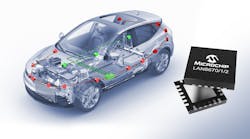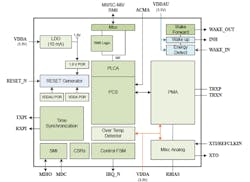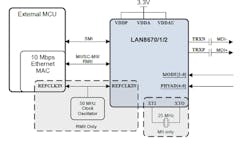This article is part of the TechXchange: Single Pair Ethernet.
With all of the multilayered activity associated with a complete network installation along with “ethereal” software to make the network function, there’s still on inescapable fact: Any network’s capabilities begin the physical connection to the media, appropriately known as the PHY layer.
Adding to the automotive Ethernet momentum, Microchip Technology introduced AEC-Q100 Grade 1-qualified 10BASE-T1S Ethernet PHYs designed according to IEEE Std 802.3cg-2019): the LAN8670, LAN8671, and LAN8672. These enable connection of low-speed devices—primarily sensors and actuators—which previously required their own communication systems, into a standard-Ethernet system in automotive applications (Fig. 1).
The 10BASE-T1S device specifications include 10-Mb/s performance, half-duplex mode, flexible topology with multidrop bus line, and point-to-point, all using a single balanced pair of conductors (Fig. 2). The devices also feature enhanced electromagnetic compatibility/electromagnetic interference (EMC/EMI) performance, especially critical in the electrically harsh automotive environment.
Support for time-sensitive networking (TSN)—critical for many applications throughout automotive zonal architectures—enables synchronized timing across far-reaching Ethernet networks (Fig. 3).
These devices include advanced PHY diagnostics to provide the user with troubleshooting capabilities. In addition, sleep/wake functionality allows for low-power modes. While the three PHY interfaces share many of the same functions and features, they do have small but important differences in addition to their package size of small footprint 24-pin, 4- × 4-mm; 32-pin, 5- × 5-mm; and 36-pin, 6- × 6-mm VQFNs with wettable flanks (Fig. 4).
Design-in of network interfaces isn’t a trivial exercise. Microchip’s support for these ICs begins with a 37-page Product Brief, and continues with a 198-page full datasheet. There’s also a brief overview of 10BASE-T1S technology, which links to downloadable demo. Going further, there’s even a 54-minute online course “10BASE-T1S Single Pair Ethernet System Integration,” which introduces the 802.3cg short reach 10-Mb/s Ethernet physical-layer standard and the PLCA collision management protocol, allowing for efficient multi-drop network implementations.
For hands-on experience, Microchip offers two evaluation boards (Fig. 5). First, there’s the EVB-LAN8670-RMII, an RMII (Reduced Media Independent Interface)-to-10BASE-T1S interface card that connects to MCUs offering RMII and to Microchip MCU evaluation boards, with screw terminals for direct cable connection. The second board, the EVB-LAN8670-USB, is a USB-to-10BASE-T1S interface card also with screw terminals.





